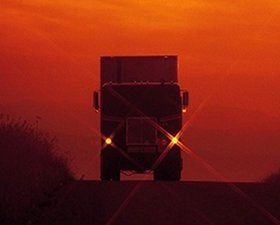Review Questions - Click On The Picture To Begin...

When making a visual check of the coupling, all of the following inspections are correct, except:
- Be certain the locking jaws are around shank and not the head of the kingpin
- Ensure the release arm is properly seated and the safety latch is unlocked
- Check that there is no visible space between the upper and lower fifth wheel
- Make sure there is enough grease
Quote From The CDL Manual:
Check fifth wheel (lower)
- Securely mounted to frame
- No missing, damaged parts
- Enough grease
- No visible space between upper and lower fifth wheel
- Locking jaws around shank, not head of kingpin
- Release arm properly seated and safety latch/lock engaged
Check Fifth wheel (upper)
- Glide plate securely mounted to trailer frame
- Kingpin not damaged
Next
Which of the following shut off valve positions is incorrect?
- All of these are correct
- Rear of front trailers: OPEN
- Rear of last trailer: CLOSED
- Converter dolly air tank drain valve: CLOSED
Quote From The CDL Manual:
Double and triple trailers:
- Shut-off valves (at rear of trailers, in service and emergency lines)
- Rear of front trailers: OPEN
- Rear of last trailer: CLOSED
- Converter dolly air tank drain valve: CLOSED
- Air lines supported and glad hands properly connected
- If spare tire is on converter gear (dolly), make sure it is secured
- Pintle-eye of dolly in place in pintle hook of trailer(s)
- Pintle hook latched
- Safety chains secured to trailer(s)
- Light cords firmly in sockets on trailers
Prev
Finish
Please select an option








 TT On Facebook
TT On Facebook